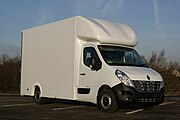Renault Master
| Renault Master | |
|---|---|
 | |
| Overview | |
| Manufacturer | Renault |
| Production | 1980–present |
| Body and chassis | |
| Class |
|
| Chronology | |
| Predecessor | Saviem SG3 Renault 50 |
The Renault Master is a large van produced by the French manufacturer Renault since 1980, now in its third generation. It replaced the earlier Renault Super Goélette light trucks[1] and the Renault 50 series of full-size vans. Opel has sold versions of the second and third series vans as the Opel Movano in Continental Europe and Vauxhall Movano in the United Kingdom. All three generations have been designed and manufactured by Renault, irrespective of the brand.
Over its lifetime several different body styles have been available, from the standard van to bigger models with an increased load area, height, and longer wheelbases with an LWB prefix. Panel vans are very common, but pickups are also available. Heavier duty models of the Master were also sold by (now Volvo owned) Renault Trucks as the B series, later as the Messenger and the Mascott.
First generation (1980–1997)[]
| First generation | |
|---|---|
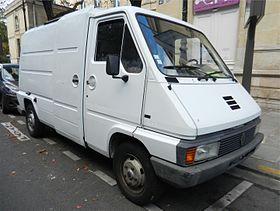 | |
| Overview | |
| Also called |
|
| Production |
|
| Assembly | France: Batilly[2] |
| Layout | Mid-engine, front-wheel drive [3] |
| Powertrain | |
| Engine |
|
| Transmission | 5-speed manual |

The original Renault Master was launched in September 1980. Originally launched with the 2.5 L (2445 cc) Fiat-Sofim diesel engine, and from 1984 also with the 2.1 L (2068 cc) power unit. In rare cases the Master was sold with a 2.0 L or 2.2 L Renault petrol engine.
In 1990, a marginally larger (2499 cc) version of the Sofim diesel replaced the earlier version.
They competed with a number of other manufacturer's products, but also with the smallest models of Renault's own Dodge 50 Series, which was latterly being built as the Renault 50 Series, after Renault's acquisition of the Dodge production facilities in the United Kingdom (at the time of Peugeot's takeover of Chrysler Europe), however, the Renault Master gradually replaced the Renault 50 series after the acquisition.
The smaller Renault Trafic was also launched in 1980, resulting in a large range of light commercial vehicles.
The Master was distinctively styled with the sliding door design and unusual round door handles, similar to those of the Fiat Ritmo/Strada. The van was manufactured at Renault's then new SoVAB Batilly plant in northeastern France.[4]
Renault B series / Messenger[]

An alternative heavier duty version which appeared almost identical, was sold by Renault Trucks as the Renault B70 to B120. It first appeared as the 70 PS (51 kW) B70 (diesel) and as the 80 PS (59 kW) B80 (petrol) in the end of 1982. It was a light truck with a Renault Master I body on a separate chassis, rear wheel drive and rear dual wheels.
The B series was offered with a range of alternative body options. As the Master (and the smaller Trafic) both carried manufacturer's plates from Renault's automobile division, RVI's production numbers appeared to plummet as the SG2 and SG3 were gradually replaced.
It was thus decided in 1982 to transfer the new, heavier B series range to RVI.[1] More powerful versions were gradually added, incorporating turbochargers and intercooling.
Although a 4x4 version of the B90 took part in the Paris Dakar Rally in 1987, the "civilian" version of the B90 4x4 truck was unveiled in 1990 only, and was sold until 1999. In 1993, the B series had a grille change and was renamed Messenger.
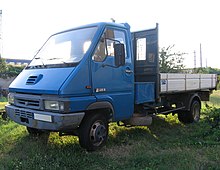

Second generation (1997–2010)[]
| Second generation | |
|---|---|
 | |
| Overview | |
| Also called |
|
| Production | 1997–2010 |
| Assembly |
|
| Layout |
|
| Powertrain | |
| Engine |
|
| Transmission |
|
| Chronology | |
| Predecessor | Nissan Trade |

The second generation Renault Master, which arrived in November 1997, was more conventional in appearance and, though primarily developed by Renault, was available from 1998 as the almost identical Opel Movano (badged in the United Kingdom as the Vauxhall Movano), and from Renault's closely related partner Nissan, from whom it was available as the Nissan Interstar.
This arrangement mirrors the collaboration between these companies on the Master's smaller counterpart, the Renault Trafic; within the industry, similar platform sharing arrangements existed between Fiat and Peugeot/Citroën, and also between Volkswagen and Mercedes.
The second generation of the Renault Master and the third generation of the Iveco Daily share many panels and some components of the cab, including the doors due to an agreement between Iveco and Renault stipulated in July 1994.
The agreement provided for the production and sharing of common components for a total of 120 thousand pieces a year produced in the various factories of Brescia (Italy, Iveco), Suzzara (Italy, Iveco), Valladolid (Spain, Iveco) and Batilly (France, Renault factory).[5]
The Master used the Renault S-Type engine in S9U and S8W/S9W versions, the G-Type engine (G9T) and the Nissan YD engine. Displacements available (not across all chassis/body sizes) included 2.2, 2.5, and 2.8 litres with a range of power outputs.
The van received a mid life major facelift in the end of 2003, with the headlight area being heavily restyled (together with cosmetic changes to rear lights, wing mirrors, and dashboard), resulting in the front end somewhat resembling the smaller Trafic. Like its predecessor, the van was available in a number of sizes and configurations, and was a popular base for conversion to ambulance bodywork.
For the facelifted Master, the 2.8 litre engine option was replaced in some markets with the 3.0 litre ZD3 engine derived from the Nissan ZD30 engine, variants ZD3 200 or 202 for transverse mount front wheel drive arrangements and variants; 600, 604, 606 or 608 for rear wheel drive arrangements. The grill was redesigned in 2007 on Renault-badged models.
Facelifted Renault Master (2003–2007)

Facelifted Renault Master rear (2003–2011)

Opel Movano A (1998–2005), low roof, short wheelbase minibus
Opel Movano A (2005–2009), medium roof, long wheelbase minibus

Nissan Interstar (1998–2003), high roof, medium wheelbase van
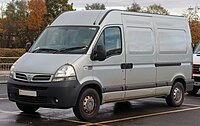
Nissan Interstar (2003–2013), medium roof, medium wheelbase van

Vauxhall Movano A
Renault Mascott[]
| Renault Mascott | |
|---|---|
 | |
| Overview | |
| Also called | Renault Master LDT/Maxi/Pro/Propulsion |
| Production | 1999–2013 |
| Layout | Longitudinal front-engine, rear-wheel drive |
| Powertrain | |
| Engine |
|
| Transmission |
|
| Chronology | |
| Predecessor | Renault B-series |
| Successor | Renault Maxity |
Renault Trucks marketed a heavy duty 3.0 L diesel version of the Master and sold it as the Mascott.[6] Other names for this rear wheel drive (RWD) version are: Master Propulsion (France), Master Pro (The Netherlands).[7]
It retained the name Master in Albania, Bosnia and Herzegovina, Croatia, Macedonia and Slovenia, Master LDT in Belgium, Master Maxi in Poland and Master Propulsion in Spain, France, Italy and Réunion.[8] Available in Europe between 1999 and 2013, it was positioned between the Master and the larger Renault Midlum.[9]
It was available in two states of tune, either 120 PS (88 kW; 118 hp) or 160 PS (118 kW; 158 hp) with five and six speeds respectively.
Pre-facelift Renault Mascott box truck
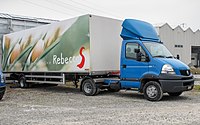
Post-facelift Mascott with Semi trailer
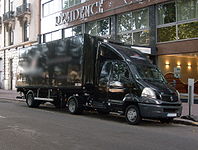
Post-facelift Mascott with Semi trailer
Third generation (2010–present)[]
| Third generation | |
|---|---|
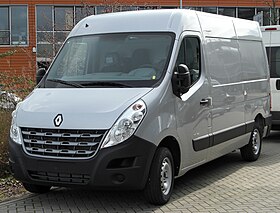 | |
| Overview | |
| Also called |
|
| Production | 2010–present |
| Assembly |
|
| Layout |
|
| Powertrain | |
| Engine | 2.3 L M9T I4-T (diesel) |
| Transmission |
|
A new generation of the Renault Master was introduced in the summer of 2010, again including the rebadged Opel/Vauxhall Movano and Nissan NV400. It is the first time that either the Opel/Vauxhall or Nissan has been available with single/twin rear wheel drive.
The M-type 2.3 litre four cylinder diesel engine is shared by all four marques, and is available in three states of tune, from 100 PS (74 kW; 99 bhp) to 150 PS (110 kW; 148 bhp). Renault Trucks discontinued the Mascott and sold the third generation Master in chassis cab format only, with payloads of up to 2.5 tonnes.[10]
In the United Kingdom, the Movano is available in a large range of height, length and weight configurations, and capable of transporting up to 4,500 kg (9,900 lb).[11] In 2014, the front grille was facelifted on the Renault Master but the facelift did not apply to the Opel/Vauxhall versions. On 18 April 2016, Renault announced starting producing an off-road version of the Renault Master, with a four-wheel drive layout.[12]
In South Korea, FF Layout Master L1H1(S) and L2H2(L) panel van were launched on 15 October 2018. They are imported from France. The first Master in South Korean market will be diesel with manual gearbox. Short version trim(S)'s price are 29,000,000won, Long body van(L)'s price are 31,000,000won. Renault Korea possibly consider the competitors as the Hyundai Starex and Hyundai H350.
In 2019, a facelifted model was introduced for the 2020 model year.
In 2021, production of the Opel and Vauxhall variants was canceled in favour of a new Opel/Vauxhall Movano sourced internally from Stellantis, based on the Fiat Ducato.

Renault Master rear panel van
Renault Master Low Loader (2011–2014)

Nissan NV400 long wheelbase panel van
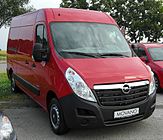
Opel Movano B medium roof, long wheelbase panel van
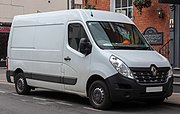
Renault Master (2014–2019)

Vauxhall Movano (Pre-facelift)

Renault Master (2019-present)

Vauxhall Movano (Post-facelift)
References[]
| Wikimedia Commons has media related to |
- ^ Jump up to: a b Kennett, Pat, ed. (September 1982). "What's New: Renault revealed". TRUCK. London, UK: FF Publishing Ltd: 17.
- ^ Walker, Alan (September 1982). Kennett, Pat (ed.). "The great European retreat". TRUCK. London, UK: FF Publishing Ltd: 37.
- ^ Personal experience. The engine is fore-and-aft, located under a hatch between the driver and passenger seats, and access is very easy. As I write, there's one parked just outside.
- ^ Renault press release 26 February 2010[permanent dead link]
- ^ "Accordo di collaborazione tra Iveco (Fiat) e Renault". La Repubblica. 26 July 1994. Retrieved 9 January 2019.
- ^ fr:Renault Mascott
- ^ "Renault Mascott / Master Pro". buzzybeeforum.nl (in Dutch). 26 April 2014. Retrieved 6 May 2014.
- ^ "Master Propulsion II" (in French). renaultconcepts.online.fr. Archived from the original on 14 May 2014. Retrieved 14 May 2014.
- ^ Roadtransport.com 12 January 2010 Archived 11 August 2010 at the Wayback Machine
- ^ Renault Trucks Master brochure[permanent dead link]
- ^ "Auto Express Movano 2011 review". Auto Express. AutoExpres.co.uk. Retrieved 16 August 2013.
- ^ "The announcing of the 4x4 system of the official site of Renault UK". Archived from the original on 26 May 2016. Retrieved 3 May 2016.
| show |
|---|
| show |
|---|
| show |
|---|
| show |
|---|
| show |
|---|
- Renault vehicles
- Vans
- Vehicles introduced in 1980












